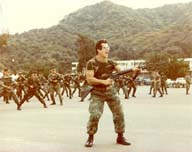
|
MARINE CORPS
BASE CAMP PENDLETON (March 29, 2001) -- The concept of a
martial arts program for the Marine Corps is not new and has
been practiced in one way or another for quite some time under
the guise of close combat training.
The only difference now is that the Commandant has made it into
standard training Corps-wide.
However, the evolution of the martial arts program has never
been easy and took quite a long time for the realization to
come about.
Former Marines like retired gunnery sergeant, Bill Miller, and
retired master sergeant, Jim Advincula, who both received a
"Black Belt Emeritus" award recently for their pioneering efforts
in martial arts. They first breathed life into the program by
incorporating their lessons according to the needs of the Marine
Corps.
"In the old days, it used to be that if you were a Marine who
knew martial arts then you were given the task of teaching it
to other Marines," Advincula said.
It is this reason that for several years a martial arts program
was never in place, but taught. However, in most cases it was
left up to the unit's commanding officers to incorporate that
type of training.
Although Miller learned his skills while on Marine Security
Guard duty in Bangkok, Siam; Advincula started his journey early
in life. Ironically, they both learned their skills in the same
area... Southeast Asia.
Advincula began his journey at the age of eight when a few friends
of his in the Philippines took his hat and jacket.
His father, a civilian worker for the Army Air Corps, was upset
about the situation and quickly retrieved his son's belongings.
However, it was this incident that spurned Advincula's father
to hire a few close friends in the Philippine Army to coach
him.
"I had several people teach me different ways in the Escrima
martial art and combat judo," Advincula said.
Practicing his art until he entered the Marine Corps in 1957
as a combat engineer, Advincula eventually found himself on
Camp S.D. Butler, Okinawa. It was here that he began teaching
his first lesson.
"I took the best that each martial art had to offer and quickly
created a system for use (in Okinawa)," Advincula said.
Recognizing faults in the hand-to-hand combat fighting technique
the Marine Corps was teaching at the time, Advincula made a
concerted effort to teach wherever he went in his 24 years of
service
"I had a big problem with hand-to-hand combat. The Marine Corps
taught that you had to take a 'stance.' That's unrealistic because
people don't fight that way. I was finding that a lot of Marines
came in to learn how to fight and they found themselves disappointed,"
Advincula said.
For example, MSgt Richard A. Pittman, now retired, recounted
an experience while serving in Vietnam.
When a North Vietnamese Army (NVA) prisoner bolted, Pittman,
guarding the prisoner, found himself in pursuit. After running
the prisoner down, it was obvious that the prisoner was not
about to give up. Pittman incorporated his hand-to-hand Marine
Corps combat training and quickly found that none of the techniques
were working.
Pittman stated, "As I was fighting him, I was trying to think
what I was supposed to do, like when he reaches out with his
right hand I am supposed to grab him with my left hand, etc.
That stuff just didn't work. I tried to use everything the Marines
taught me, but it just wouldn't work."
It was that experience that caused Pittman to stress the extreme
violence that close combat entails and to become a staunch advocate
on close combat teachings. It was also that experience that
convinced Advincula, an acquaintance of Pittman's, that things
had to be done differently.
Although he was only one man, upon coming home from Vietnam,
Advincula continued his teachings to Marines.
"Many people believe that if you teach a Marine how to kill
with his bare hands that he will go out and use it. What they
don't understand is that the martial arts instill discipline.
By learning how to fight, you don't want to fight," Advincula
said.
Nevertheless, the importance of using an issued weapon before
martial arts was stressed in his teachings.
"A Marine should use his weapon until it can't be used anymore.
After that, he should take the enemies weapon away and use that.
After that, he should improvise and use whatever is around.
Once all the Marine's options are exhausted then he should use
his hands," Advincula said.
It was this type of philosophy a lieutenant colonel experienced
firsthand as commanding officer of 3rd Battalion, 9th Marine
Regiment.
This officer is now our 32nd Commandant and although Gen. Jones
had already made up his mind about martial arts as a young lieutenant
in Vietnam, he described the experience at 3/9 as "startling,"
according to a recent USA Today edition.
Today, Advincula is quite pleased the Marine Corps has finally
adopted an official martial arts program and hopes that it will
remain for years to come.
"I don't know if I had anything to do with it, but it's what
I've been saying for years," Advincula said.
